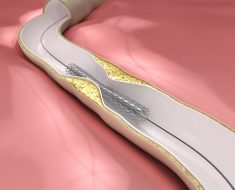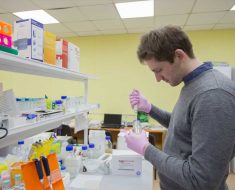Even the briefest increase in airborne fine particulate matter PM2.5, pollution-causing particles that are about 3 percent of the diameter of human hair, is associated with the development of acute lower respiratory infection (ALRI) in young children, according to newly published research. Increases in PM2.5 levels also led to increased doctor visits for these lung infections.
The groundbreaking study, “Short-Term Elevation of Fine Particulate Matter Air Pollution and Acute Lower Respiratory Infection,” is the largest to date on this health concern, involving more than 100,000 patients.
The research was undertaken by a team from Intermountain Healthcare, Brigham Young University and University of Utah and is published online in the American Journal of Respiratory and Critical Care Medicine, an American Thoracic Society journal.
“The most important finding of this study is that infectious processes of respiratory disease may be influenced by particulate matter pollution at various levels,” said lead author Benjamin Horne, PhD, director of cardiovascular and genetic epidemiology at the Intermountain Medical Center Heart Institute in Salt Lake City, Utah. “The exact biological implications of the study’s findings require further investigation.”
Dr. Horne and colleagues studied 146,397 individuals who were treated for ALRI between 1999 and 2016 at Intermountain Healthcare facilities throughout Utah’s Wasatch Front region. The Wasatch Front is approximately 80 miles long and 10-20 miles wide, bordered on both sides by mountains. It consists primarily of suburbs, but also includes the cities of Salt Lake City, Ogden and Provo/Orem.
PM2.5 levels were estimated based on data from air quality monitoring stations along the Wasatch Front, where approximately 80 percent of Utah’s population resides. Measurements were also made at secondary locations. Short-term periods of PM2.5 elevation were matched with the timing of increases in health care visits for ALRI.
The primary aim of the study was to determine if there was an association between these fine particulates and ALRI in very young children, with a secondary objective of finding the same associations for older children, adolescents and adults.
The research team found ALRI associated with elevated levels of PM2.5 in both children and adults – even in newborns and toddlers up to age two, who represented 77 percent (112,467) of those who had an ALRI diagnosis.
Nearly 60 percent of U.S. children live in counties with PM2.5 concentrations above air quality standards. This study was performed in a location where the average daily PM2.5 level is lower than places like Los Angeles and New York. Due to the topography of the region, though, air pollution may become trapped in the high mountain valleys of the Wasatch Front—especially during temperature inversions, which typically occur in the winter months. When PM2.5 becomes trapped in the valleys, this often leads to sharp increases in PM2.5 to levels considered to be unhealthy (>35 micrograms per cubic meter, and at times approaching 100 ug/m3).
“In many places that have higher average PM2.5, the PM2.5 level does not vary as much as it does on the Wasatch Front, so it is not clear how this study’s findings may transfer to those locales where the air pollution exposure is higher over the long term but short term spikes do not occur,” said Dr. Horne. “It may be, though, that long-term exposure to air pollution makes people more susceptible to ALRI on a routine basis, although additional studies will be required to test this hypothesis.”
Bronchiolitis, a condition in which small breathing tubes in the lungs called bronchioles become infected and clogged with mucus, is the most common acute lower respiratory infection in children.
Fifty to 90 percent of bronchiolitis cases are caused by respiratory syncytial virus (RSV), which is the most common cause of hospitalization in the first two years of life. Sixty-four percent of individuals studied had a diagnosis of bronchiolitis.
“Overall, it took about 2-3 weeks for the ALRI hospitalizations or clinic visits to occur in this study after the rapid rise in PM2.5 had been observed,” said Dr. Horne. In an analysis of death rates among the study population, 17 children ages 0-2, 9 children ages 3-17 and 81 adults (> age 18) died within 30 days of diagnosis with ALRI.
In theorizing about the connection between PM2.5 and ALRI, Dr. Horne said: “The air pollution itself may make the human body more susceptible to infection or may impair the body’s ability to fight off the infectious agents. It may be that PM2.5 causes damage to the airway so that a virus can successfully cause an infection or that PM2.5 impairs the immune response so that the body mounts a less effective response in fighting off the infection. This could lead to longer periods of ALRI symptoms or more severe symptoms requiring a higher intensity of medical care for the infected individual. It may also be that periods of acute increases in PM2.5 lead people to stay indoors more where they are in closer contact with others who carry infectious agents and can transmit the infection to them.”
Motor vehicles contribute about 48 percent of emissions that lead to the formation of fine particulates. Small industry and businesses such as gas stations and dry cleaners, as well as home heating, emit about 39 percent of all fine particulates. Large manufacturing accounts for 13 percent.
Source: Read Full Article





